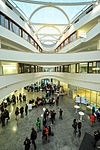Groß Flottbek
Altona, HamburgQuarters of Hamburg

Groß Flottbek (German pronunciation ), (Great Flottbek) is a quarter of Hamburg, Germany, in the borough of Altona. It is located in the center of the borough north of the Othmarschen quarter. Near Groß Flottbek, the neighbourhood of Klein Flottbek, which is not an official quarter, can be found. Around 11.000 people live in Groß Flottbek on 2.4 sq km.
Excerpt from the Wikipedia article Groß Flottbek (License: CC BY-SA 3.0, Authors, Images).Groß Flottbek
Baron-Voght-Straße, Hamburg Groß Flottbek (Altona)
Geographical coordinates (GPS) Address Nearby Places Show on map
Geographical coordinates (GPS)
| Latitude | Longitude |
|---|---|
| N 53.56536 ° | E 9.87759 ° |
Address
Baron-Voght-Straße
Baron-Voght-Straße
22607 Hamburg, Groß Flottbek (Altona)
Germany
Open on Google Maps









